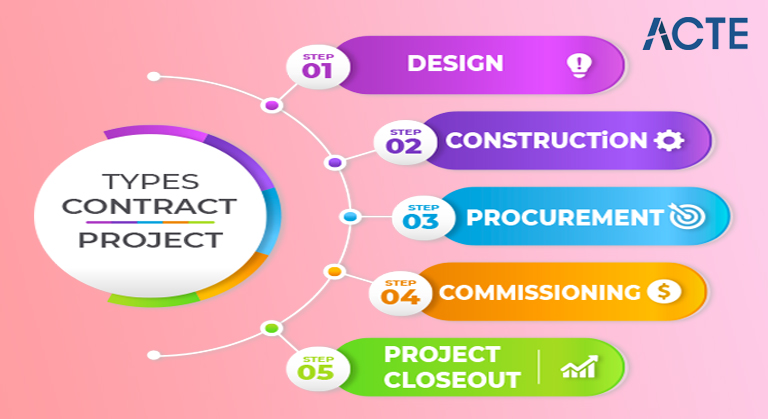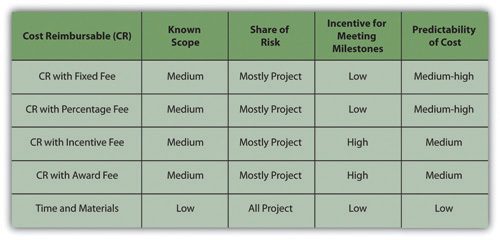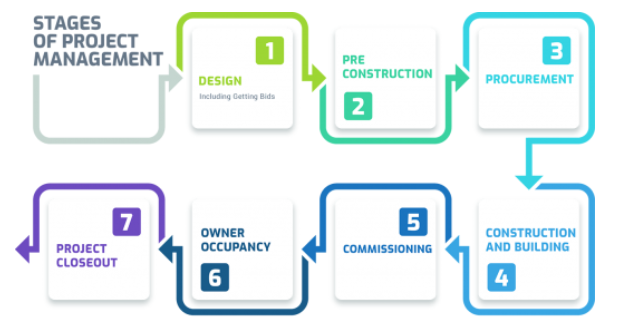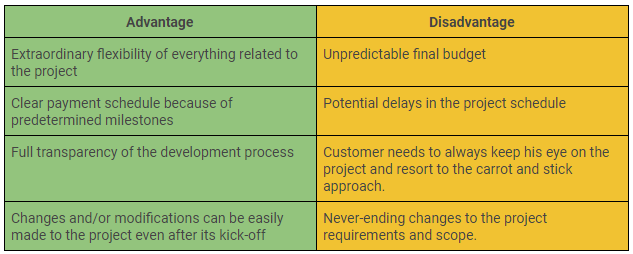
- Introduction to Project Contract Types
- Types of Contracts in Project Management
- Fixed Price Economic Price Adjustment (FPEPA)
- Cost Plus Fee (CPF) or Cost-Plus Percentage of Costs (CPPC)
- Time and Material Contracts or Unit Price Contracts
- Creating a Project Contract in 5 Steps
- Types of Contracts Used in a Construction Project
- Obtainment Example for Understanding Contract Types
- The situation I – Fixed Price
- Situation II – Time and Material
- Situation III – Cost Reimbursable or Cost Plus
- Significant Notes to Remember
- Advantage and Disadvantages of Time and Materials Contracts
- Advantage of T&M Contracts
- Advantage and Disadvantages of kind of agreement
- Conclusion
- In the realm of business, contracts are utilized for laying out business arrangements and organizations. The gatherings associated with the business commitment choose the kind of agreement.
- Normally, the kind of agreement utilized for the business commitment fluctuates relying upon the sort of the work and the idea of the business.
- The agreement is essentially an explained arrangement between at least two gatherings. At least one gathering might give items or administrations consequently to something given by different gatherings (client).
- The agreement type is the critical connection between the gatherings occupied with the business and the agreement type decides the task hazard.
- Let’s examine the most broadly utilized agreement types.
- Complete Name, Address, and Signatures of Both Parties
- Depiction of Work
- General Terms and Conditions
- Project Cost and Payment Terms
- Project Insurance and Delay
- Liabilities for Damages
- Termination
- Fixed Price Contract (FP)
- Time and Material Contract (T&M)
- Cost Reimbursable Contract (CR) or Cost-Plus Contract.
- Type and intricacy of necessity.
- Degree of value contest.
- Cost and value investigation.
- Direness of necessity or execution period.
- Recurrence of anticipated changes.
- Industry guidelines of sorts of agreements utilized.
- Whether or not there is a clear-cut assertion of work.
- Generally speaking, level of cost and timetable danger
- These are otherwise called Lump Sum contracts. The vendor and the purchaser settle on a decent cost for the task. The dealer regularly acknowledges a significant degree of hazard in this kind of agreement. The purchaser is at all hazard classification since the value the dealer consented to is fixed. Be certain this kind of agreement has completely nitty-gritty determinations, agendas, and venture scope explanations from the merchant side, which the purchaser will utilize.
- With this sort of agreement, vendors might attempt to slice the degree to convey the activities on schedule and inside the spending plan. Assuming the venture is done on schedule with the ideal quality, the task is over for that agreement. Be that as it may, if the task is postponed and there are cost overwhelms, the vender will ingest every one of the additional expenses.
- What do you do when the extent of the work isn’t clear? A fixed-value contract is impossible since you are don’t know what the task will require. Here’s the place where you’d utilize an expense reimbursable agreement.
- An expense reimbursable agreement otherwise called an expense reimbursable agreement is utilized when the venture degree is questionable, or the undertaking is in high danger. The purchaser pays all costs, so the purchaser bears all the danger. Under an expense reimbursable agreement, the merchant works for a decent time frame period and raises the bill in the wake of completing the work-a charge that addresses the benefits for the agreement. The expense might be subject to chosen project execution or different measurements.
- A significant disadvantage of this kind of agreement is that the merchant can raise a limitless or obscure sum which the purchaser is constrained to pay. For this reason, cost, reimbursable agreements are seldom utilized. The following are a couple of kinds of cost-reimbursable agreements:
- Names of the gatherings in question
- A portrayal of the undertaking that should be finished
- Licensed innovation
- Course of events
- Charges and costs
- Contract end
- In light of over two gauges, the Contractor can assess Labor and Material Costs. The Contractor would add up to these Estimates and add some benefit to furnish us with a Fixed Price Quotation.
- This Quotation (once concluded and acknowledged by us) would turn out to be important for the Contract. We should follow through on a Fixed Cost to the Contractor for finishing the work. Regardless of whether the Contractor invades his appraisals, we would not be responsible to pay anything extra.
- This situation is like Scenario II above. This situation would come if the Electrical format and configuration were not accessible to us. Assuming that is the situation, we cannot give a nitty-gritty SoW to the Contractor. Without a trace of a Sow, the Contractor cannot decide a sensible gauge of the expense.
- Also, let us expect that Market (Economic) Conditions are continually evolving. There is a consistent variance of Labor Rates and Wire Rates on the lookout. If such conditions endure then the Contractor can’t sensibly appraise Fixed Rates.
- In this Scenario, the Contractor would propose (since Labor Rate and wire Rate can’t be decently assessed) that the Actual Costs brought about by her/him ought to be Reimbursed. Moreover, the Contractor would request a Suitable Fee for the administrations that she/he would deliver to finish the work.
- This proposition (once concluded and acknowledged by us) would turn out to be part of the Contract. Neither the Rates nor the Quantity would be Fixed for the term of the Contract. All things being equal, we should Reimburse every authentic Cost and give an (Agreed upon) Suitable Fee to the Contractor.
- The gatherings included should be recognized obviously by their right legitimate names or maybe identifiers.
- At least one gathering should offer the assistance, undertaking, or item.
- There should be a thought or advantage presented because of the said offer in the agreement.
- The length of the exchange should be finished within a predefined period.
- The idea of the venture gave, the advantage offered, or the gatherings included should exclude criminal behavior and each party should consent to the agreements.
- Without a not-to-surpass proviso and greatest covers on costs, you might end up confronting issues with dealings or workers for hire exploiting these missing things. You need to manage the broad course of effectively following the materials being utilized for the task as well as the billable hours, which can be hard to accomplish, particularly as you’re maintaining your independent venture. The degree of inclusion in a T&M contract is undeniably more than that expected in a fixed-value contract. There’s no settled spending plan, and that implies all out expenses can far surpass what you expect to need to pay at first.
- Since there are a ton of obscure factors in the task that prompt a T&M contract, there are normally numerous potential drawbacks that emerge from these factors. It’s essential to painstakingly think about whether or not the disservices offset the danger. If not, you might need to take as much time as necessary to do additional exploration encompassing your venture and consider a fixed-value contract all things being equal.
- Previously, the planning stage and the forming stage were isolated. First and foremost, the structure is planned by draftsmen. Furthermore, workers for hire dissect the engineering plan and bid on the sum that it will cost to develop the undertaking. Thirdly, when the bid sum is settled upon, development happens.
- At the point when the two stages are isolated, it regularly prompts issues. It isn’t exceptional for the client to become miserable when the plan clashes with what can be constructed. To kill this issue, you can now utilize configuration assemble workers for hire which incorporate both the plan and construct stage together.
Introduction to Project Contract Types:
What is Project Contract?
An undertaking contract is a shared understanding between at least two gatherings connecting with the arrangement of explicit work administrations in return for concurred remunerations (for the most part cost or potentially any others determined in the agreement). The agreement incorporates agreements that are to be trailed by elaborate gatherings.
How Treats Project Contract Consist Of?
A task contract comprises of the accompanying subtleties:
What are the 3 Types of Project Contracts?
Coming up next are the kinds of undertaking contracts:
Are Project Contracts Legally Binding?
A task contract is lawfully restricting and can be utilized even in an official courtroom if either party neglects to respect their responsibility towards the agreements of the agreement. After shaming the agreement, settlements can happen in court.
What Makes a Contract Invalid?
An agreement will in general be invalid on the off chance that it doesn’t stick to a few legitimate conventions. Additionally, assuming a party’s terms end up being unlawful, or abuse public approach or a party’s rights, then, at that point, it very well may be considered invalid.
Types of Contracts in Project Management:
Assuming an association chooses to “purchase” from at least one external source, it should choose the sort of agreement it needs. In choosing what kind of agreement to utilize, the essential goal is to have hazard disseminated between the purchaser and dealer so the two players have inspiration and impetuses for meeting the agreed goal. The following variables might impact the sort of agreement chosen:
Fixed Price Contracts:
The following are a couple of kinds of fixed-value contracts:
Fixed Price Incentive Fee (FPIF):
Albeit the cost is fixed, the dealer is offered a presentation-based motivating force. The impetus can be reliant upon at least one undertaking measurement like execution, cost, or time.
Fixed Price Award Fee (FPAF):
Assuming the exhibition of the vender surpasses assumptions, an extra sum (i.e., 10% of the absolute cost) will be paid to the merchant.
Fixed Price Economic Price Adjustment (FPEPA):
The decent cost can be re-resolved relying upon the market valuing rate.
Cost Reimbursable Contracts:
Cost Plus Fee (CPF) or Cost-Plus Percentage of Costs (CPPC):
The merchant will get the complete expense they caused during the venture in addition to a level of the charge over cost; this is gainful 100% of the time for the dealer.
Cost Plus Fixed Fee (CPFF): The dealer is paid a decent sum that is settled upon before work starts. The expense brought about on the venture is repaid on top of this, paying little heed to project execution.
Cost Plus Incentive Fee (CPIF): A presentation-based motivator expense will be paid to the vender far beyond the real expense they have brought about on the undertakings. With this sort of agreement, the motivator is a rousing component for the dealer to meet or surpass the undertaking’s presentation measurements.
Cost Plus Award Fee (CPAF): The dealer will get a reward sum (the honor expense) in addition to the real expense caused by the activities; this sort of agreement is the same as a CPIF contract.

Time and Material Contracts or Unit Price Contracts:
Unit value contracts are what we generally call hourly rate contracts. This sort of agreement is a half-breed of an expense reimbursable and fixed-value contract. For instance, assuming the vendor burns through 1,200 hours on a task at $100 60 minutes, the merchant will be paid $120,000 by the purchaser. This sort of agreement is normal for specialists, and the primary benefit of this agreement type is that the dealer brings in cash for each hour spent chipping away at the undertaking.
What to Include in a Project Contract?
A task contract should be set up while accomplishing project work. This applies to workers for hire as well as to understudies doing a venture. A task contract contains every one of the essential components required for an agreement to be substantial. While agreeing interestingly, make a point to incorporate the things underneath.
Creating a Project Contract in 5 Steps:
Making an undertaking agreement probably won’t be just simple. Thus, you can utilize the means referenced underneath to make the ideal agreement for your undertaking:
Stage 1: Title of the Contract: The title is a significant piece of the agreement as it shows what’s essentially going on with your agreement. One glance at the tile and the peruser ought to have the option to enlighten about the agreement could. There are many agreement layouts in Pages that could be of incredible assistance to you on the off chance that you need to make the right sort of an agreement in the Word design. The title ought not to be excessively long, or excessively short. It simply must be correct.
Stage 2: Project Description: The task depiction should be a concise one on what the venture will be about. This need excludes each moment’s subtleties of the primary proposed project, yet it should simply give a concise outline of what’s going on with the task. The spending plan assumes a significant part in the task, so it ought to be referenced come what may. All the installment contributions, expenses, and so forth ought to be portrayed in the undertaking so the gatherings associated with the agreement will know what’s going on with it.
Stage 3: Schedule of the Project: The subsequent stage is incorporate a timetable that determines the course of events of the days the venture ought to be finished and how to do as such, isolating it as per every day. Recall that this should be a fair gauge, however, you can likewise incorporate data regarding how distinctively the timetable can be taken care of. Work contract formats assume a significant part on the off chance that you need to make explicit agreements specifically occupations and a business.
Stage 4: Laws, Terms, and Conditions This is perhaps the main advance to deal with. You should specify what is the state regulation you follow with the goal that everybody engaged with the agreement will know as well. Furthermore, you should refer to the agreements of the agreement, as this will make it more straightforward for others to get what they ought to do and can’t. These behave like standards and guidelines, so everybody knows their positions impeccably.
Stage 5: Review and Signatures: The last advance is to check the agreement again on the off chance that you have missed any subtleties you want to specify in it. Review it and roll out any improvements that are required. Whenever that is done, the following stage is to get the marks of the multitude of gatherings included so presently, the agreement is a lawfully bound record. Test HR contract formats will assist you with making the ideal agreements for the HR division.
Types of Contracts Used in a Construction Project:
Unit Price Contract: Construction work frequently includes supplies and material utilized in the structure cycle. This is enthusiastically suggested when there is a characterized rundown of the things utilized in the task.
Single amount Contract: In this sort of agreement, the development organization consents to do the occupation at a proper cost. This is utilized when there is a reasonable extension and timetable for the venture, consequently taking into account a decent gauge of the absolute expense.
Cost Plus Contract: This agreement makes the client pay for all materials and work that are exhausted by the development organization.
Motivator Contracts: The organization is remunerated in light of their exhibition and culmination of the undertaking.
Level of Construction Contracts: The remuneration the development organization gets is determined on a level of the absolute expense of the venture. We have project contract formats that are not difficult to use in this article. Make certain to think about utilizing them when you want one. While accomplishing project work in media outlets, these independent agreements, music agreements, and creation agreements would be helpful for you.
Obtainment Example for Understanding Contract Types:
Allow us to comprehend these Contracts with the assistance of a little model. Allow us to accept that we need to do a house remodel project. As a component of remodel, we want to rework the entire house. There would be two wide expense parts for the revamping the house:
Human Resource (HR) Cost for example Work Cost
Material Cost which incorporates Wire Cost
Allow us additionally to accept that we (Buyer) have called an Electrical Contractor (Seller) to give us a Quotation for re-wiring the house. To set up the Quotation, the Contractor would begin by assessing the expense for example the costs that Contractor is probably going to cause. The Contractor would consider previously mentioned costs parts (HR and Material Costs) to show up at a gauge. There could be three distinct situations for showing up at a gauge. These situations would rely on:
How much data we (as a purchaser) have imparted to the Electrical Contractor?
What is the current market (financial) conditions?
The Contractor would pick one of the potential situations to show up at a gauge and give us a citation in light of that. Allow us to investigate these situations exhaustively to comprehend the three fundamental Contract types.
The situation I – Fixed Price:
Allow us to accept we called a Building Architect before calling the Electrical Contractor. The Architect furnished us with a complete Electrical Layout and Design. The Architect additionally gave us Material Specifications of the Wiring to be utilized. We have concluded everything before the Contractor strolled in. We arranged an itemized Statement of Work (SoW) for the Contractor. The project worker would concentrate on the nitty-gritty Statement of Work (settled plans and material determinations) to give a Fixed Price Quotation.
HR Cost – The project worker would take a gander at the entire house and a structural plan to appraise the number of Labor units (length and exertion) would be expected to finish the work.
Material Cost – The project worker would overview the house and study the Electrical Layout and Design to estimate the amount of Wire (amount of wire) that would be required.
Situation II – Time and Material:
This situation would come if itemized Electrical format and configuration isn’t accessible with us. Assuming that is the situation, we can not give a point-by-point SoW to the Contractor. Without even a trace of a Sow, the Contractor can not decide a sensible gauge of the expense.
HR Cost – Since the Electrical Layout and Design are not accessible, the Contractor would not have the option to assess the number of Labor units (length and exertion) that would be expected to finish the work. The Contractor can be that as it may, gauge the Labor Rate each Day (or some other unit of time for example hour or week).
Material Cost – Again the Contractor would not have the option to appraise the amount of wire that would be expected to finish the work. The Contractor can, nonetheless, gauge the Rate per Meter (or some other unit of amount for example Kg) for various kinds of wires required.
The project worker would add a reasonable edge to assess Labor and Material Rates for re-wiring the house. The Contractor would give top-up Rates to us as a Fixed Rate Quotation. These Rates (once settled and acknowledged by us) would turn out to be part of the Contract. These Rates will stay Fixed for the length of the Contract. We should pay the Rate to the Contractor for finishing the work. The real amount of Labor and Material consumed (for making the last installments) will be resolved solely after the work is done.
Situation III – Cost Reimbursable or Cost Plus:

Significant Notes to Remember:
While planning a task contract, the main thing to consider is to ensure that the agreement can be safeguarded in a courtroom, or then again assuming it is as per the law. For reference, you should see our example layouts that arrangement with this sort of archive. Redesign contract formats will assist you with making the right sort of agreement assuming you work for a renovating business organization. They will be of incredible assistance and will prove to be useful when required. That being said, it is as yet vital to take note of the fundamental parts of an agreement. Every one of the gatherings included ought to have the option to go into a conventional agreement. This implies that they should exist in reality, are of legitimate age, and have a sound psyche.
Advantage and Disadvantages of Time and Materials Contracts:
Each agreement accompanies upsides and downsides that are critical to evaluate before you start making the particular agreement for the people or association you’re working with. Be that as it may, what are the benefits and weaknesses of time and materials contracts?. How about we separate each of these to improve the outline of what’s in store while picking this sort of agreement over different choices available to you.
Advantage of T&M Contracts:
a) Give you the adaptability required in your understanding as you’re just paying a limited sum for the materials and time taken to finish the task
b) Make arranging agreements simple as these are laid out rapidly while composing a T&M contract (as long as you and the project workers can agree and neither one of the gatherings attempt to arrange terms that would just give advantages to themselves)
c) Permit you to cover the most extreme measure of hours for the venture, which makes it so you don’t need to manage clients who might take as much time as they need to get more cash-flow
d) Regardless of whether there are deferrals or tasks are done surprisingly quickly, there are not many results while utilizing this sort of agreement. Generally speaking, T&M contracts permit you the adaptability you really want when you can’t gauge the extent of the undertaking while you’re enrolling the assistance of a worker for hire.
e) That being said, there are a few weaknesses that accompany picking a T&M contract rather than a fixed-value contract, which is an agreement where there is a set date for culmination and careful agreements in regards to the expense of materials and pay.
Disadvantage of T&M Contracts:
Advantage and Disadvantages of kind of agreement:
Advantage of Design and Build: Deduction of the Costs, Time, and Mistakes:
These plan and fabricate project workers are experts in naming both plan and development specialists and making the interaction a lot more straightforward for the landowner. For instance, there is no compelling reason to employ an assortment of the workers for hire to do all parts of the structure venture and courses of action with different subcontractors:
Individual party in question – it is productive to stay away from struggle and befuddle any correspondence between the different gathering’s association.
Costs saving – Under a party in question, it is more productive because of avoidable duplication of labor supply and both the plan and building processes in a similar organization, the data between the two matches. That implies the expense of recreation work will be all around controlled inside the spending plan since there is less chance of miscommunication when a similar plan project worker is dealing with the two stages. Since the organization knows about the entire spending plan limit, she can rapidly and precisely decide whether specific changes would invest the remaking effort over the spending plan.
Efficient – The Design and Build interaction could dispose of another serious offering process that frequently adds to the task consummation time. Moreover, assuming the plan and development segment happen simultaneously, it would save lead time throughout the reproduction work
Further developed Risk Management – Every part of the task has been painstakingly evolved through the cooperation of the project worker, architect, manufacturer, and client. Each party included knows about what they’re liable for and has facilitated their endeavors with each other. The interaction turns out to be more effective to decrease how much danger is implied
Expanded Quality Control – On the one hand, under a party in question for each progression of the interaction advances the stronger way to deal with the redesign. One party arranging every part of the rebuild guarantees that the principles are met all through and the objective is all the more precisely conveyed on the other hand, one of the huge reasons that the clients will quite often incline toward taking on the Design and Build project workers in light of their capacity to deal with everything “in house”. This is extremely interesting to clients since it implies that nobody will compromise with the nature of materials or work. It is likewise extremely advantageous to have a similar worker for hire work for the task from beginning to end.

Disadvantage of Design and Build:
Conclusion:
1. Associations in both people in general and private areas are confronting expanding strain to lessen costs and work on monetary and functional execution. New administrative necessities, globalization, expansions in agreement volumes, and intricacy have brought about an expanding acknowledgment of the significance and advantages of the successful agreement of the executives.
2. The developing acknowledgment of the need to robotize and work on legally binding cycles and fulfill expanding consistency and logical necessities has likewise prompted an expansion in the reception of more formal and organized agreement the executive’s strategies and an increment in the accessibility of programming applications intended to address these requirements.
3. The exhibition must allot chose and set in the agreement offer clear proof of the achievement (or in any case) of the relationship. When picked, the necessities supporting the exhibition measures should be the essential concentration for a contract the executives. They ought to give the structure around which supplier data prerequisites and streams, contract supervisory crews, abilities, cycles, and exercises are created.






